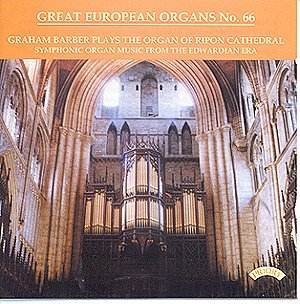The organ of Ripon Cathedral is a very large instrument
as the cover of this CD shows. It has been upgraded and enlarged progressively
since it was built in 1878. It certainly makes a magnificent noise,
which these pieces are of the period to utilise. In fact, only Stanford’s
Fantasia and Fugue and Bairstow’s Legend have other recordings in the
catalogue. I am very tempted to say "No wonder"; for the most
part. Stanford excepted, the level of composition is poor. The works
end up as repetitious meanderings and Rosalias without any sense of
purpose or aim. I said the one exception was Stanford; he stands head
and shoulders above the other composers here. The Fantasia and Fugue
is initially chromatic and then features broken arpeggios which are
skilfully played. The fugue is of a standard pattern and well worked
out. His March was written for the installation of Lord Rayleigh as
Chancellor of Cambridge University where Stanford was Professor of Music.
It is a typically grandiose work to accompany the pomp and ceremony
of such an occasion.
Graham Barber gives as good a performance as can be
hoped for, given the material with which he has to work. The organ responds
well to its demands. Throughout the sound is magnificent and matched
by the recording. From the specification there are 59 stops but the
number of pipes is not given. Suffice it to say that the playing is
excellent, the registration ideal for the period, and if the programme
appeals, one will not be disappointed. To summarise, a disc for organ
enthusiasts; the ordinary listener may well find it hard going.
John Portwood

